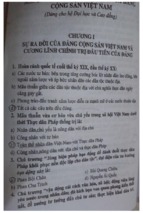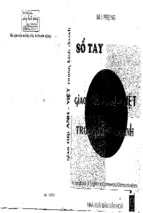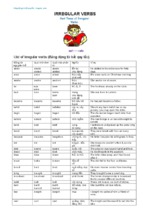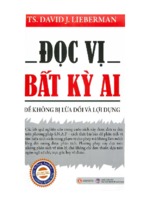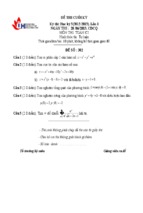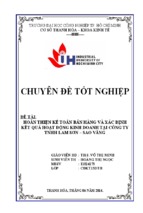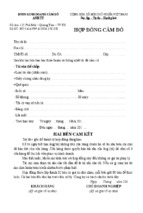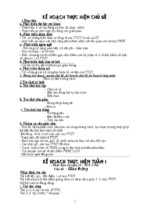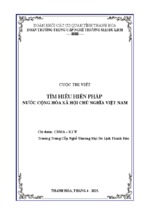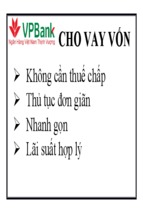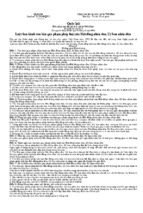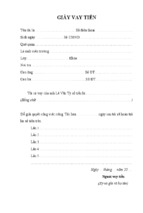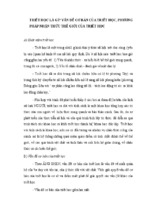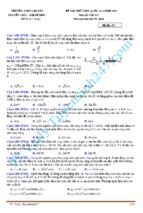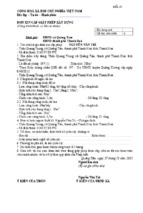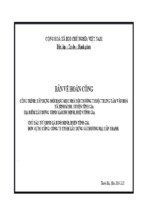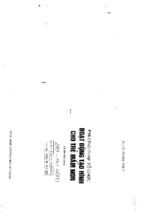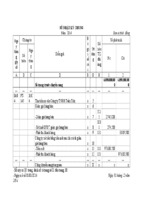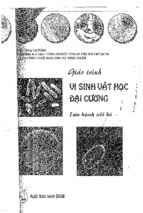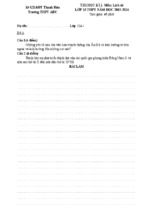CCĨITEMĨS
?RE?ACE
1
A. gTRODUCTION
I . Lexicơlogy , i t s s i i b j e c t 'm a t t e r . and task
I I . The s i g n i f i c a n c e
o f le x i c o lo g y
L exicology ỉn i t s r e l a t i o n
and s t y l i a t i c s .
5
to pnonology
IV, Some g e n e r a l c h a r a c t e r i s t ỉ c s o f the
Exỉglỉah lạnguage .
B.
2
«ORD SĨRƯCTURE ANDPORKATION
6
8
11
I.
Word a t r u c t u r e
11
II.
7ord í*orraation
15
c . S£iiiÃ33ũIiOGỵ (sem aạtioa
I.
Typea o f meanixig
)
53
53
II.
The components o f l e x i c a l ựieanỉng
54
III*
The ty p e s’ o f lex ỉcaX mẹaning
57
r/.
M o tiv a tic n of word3
57
V,
Polysemy and sem antic 3 t'ru c tu re
59
VI,
ĩlie a t y l i s t i c a a p e c t o f E n gliah
v o cabu lary
V II, Polysemy , homonym> and c o n te x t .
VIII,Homonyraa
59
S7
'6 9
E í.
Synonyms
72
X,
Antoayma
75
XI,
Semantic change
77
D. FriRAS£OLŨGY
92
- 2 A D ^ í n ì l i o n and o n a r a c t e r i - S t í c fe e t u r o n
11«
C la ssiíic a p io n
94
IIIo Proverfcs. td io m í , c^ưctaTLons ,
c l i c n e s and s a y i n a s .
rỳ .
E.
p.
s.
9ố
3 e t e)ípỉ:e?5Ìon5 v e r s u s coBipound v/ords. 98
Emoi306V
100
I.
Basic &ssun',p'tijns
lOC
II.
A s s im ila tic i: o f borrovvings
102
I I I . B arbarism s (u u assi.T iìla te d 'bo rroivỉn gs; .
103
rv .
B ty m o lo gical doaib lets
103
V.
I n t e r n a t i o n a l worda
104
VI,
Causes o f borro'.vlng
1C4
L2>:iC0G<0im
105
I.
Iiiajor problem s
105
II.
Types o f E n g lig h d i c t ỉ o n a r i e s
106
LIAĨH VARIEĩ IES 0F THE ENCLISK VOCAẺULAf?Y. , icg
ỉ.
S ta n d ard E n g lia h v a r i a n t s and d i a l e c t s
in the U.K.
108
II.
TỊie American v a r ỉ a n t ( American
E n g lish )
111« A u s t r a l ia n , In d ỉa n , and C anadian
v a ria n ta .
109
ni
Si.i.^ơegted t o p ic s f o r g r a d u a tỉo n p a p ers
li6
Ĩivefere.nce9.
118
PREKAGiỉ
T h is r a a t s r i a l Í3 in te n đ e d f o r the 4^^
yaar
s tu d e n t a o f th e E n g lish Department ÌTt th e Kanoi
U n ỉv e r a ity c f P oreign Lun*^...3.ge T eachers . I t can
a ls o be , aa a m a tte r o f ;'a c t , used f o r S n g lỉa h
a tu d e n r s i a che l a t e r y e a r s in o t h e r u n ỉ v e r s i t i e s
s in c e i t only t r e a t a o f th e e a s e n t i a l f a c t a o f
le :n ic c lo g y i n g e n e ra l anề H n^lỉsh ĩe x ỉc o lo g y in
ọ a rtỉc o la r •
Havlng c o n a ỉd a re d th e l e v e l o ỉ o u r Btudenta*
knowli.dgo o ĩ E n g lia h , ’»0 have t r i e d , a s f a r ae
p o a a ib le , to make t h l s c o u rs e n o t q u ỉ te " t h e o r e t l c a l l y th e o re tií.a l" but " p r a c tic a ily th e o re tlc a l" *
E ri^lỉsh and R u ssỉan l i n g u i a t s lo o k a t the word froĩn
r a t h e r d i f f e r e n t a n g le s th u a d e s c r ib ỉ n g i t r a t h e r
d ỉ f f e r e n t l y . We have to corabine th o se sc h o o ls o f
thought i n auch a way t h a t o u r •stud en ta w ỉ l l havo
ĩ a a a d i f f i c u l t i e a ỉn the s tu d y o f t h l a 8 u b je c t .
To h e lp improve oux* a tu d e n ts * comprehenaion , a
c e r t a i n araount of tlme Ỉ3 to be dev oted to sem inara
f o r which a p e c i f i o toplcB have bees s e le c te d « They
a r e r s q u i r e d to do a l l th e e x e r c i s e s i n th e víTỈtten
f o rm
'
>Ve b e n e í i t e d g r e a t l y from t a l k a and d iscu asỉox ỉs
w ith o u r c o ĩle a g u e a . L«t u s h e r e thank a l l o f them
f o r Vnat th sy havB d i r e c t l y o r i n d i r e c t l y c o n t r l b u t e d
Hoàng T ắt ĩrưồTig
A.. DÍTRODXTION
I / L^ẫclcologv
ỉ t a Bub^ect m a tte r and t a s k .
L ị n g u ỉs t ỉc c a a te r ia l Ì8 g e n e r a lly a rr a n g e d ln to
phonology , grarmnạr and l e x ỉ s ( o r Tocabulary ),T h e e e
t h r e e d.l8tÌJict diraenslona a r e the e u b je c t m a t t e r o f
tho Y arlõ u s liD ^ u ÌB tlc t>raQChes,
The word " l e x ic o lo g y " o r i g ỉ n a t e e from Greek
and i s compoeod o f two p a r ta t ” l« x l« " raeaning "word"
and " lo g o s " meaning " á clen ce , l e a r n in g **, thuB
" le x ic o lo g y " l i t e r a l l y neana " th e Bcỉence o r th e a t u á j
o f the word". HovreTar, t h ỉ s Ì8 Ju » t a vague n o t i o n about
the 8tỉbject matter aBd task of lexlcolog;
Bince all
the
oth® r branches o f l i n g u i s t i c s c ỉe a s e a le o r e fi» r to tho
wordl.
Ắa a tr a u c h o f
le x ic o lo g y h a s ỉ t a
a p e c i í l c aliBs and methoda of 8 c i e n t i f ỉ c r e s e a r c h ,
* í8 8 en tỉal taak b e ln g th e study and a y a te m a tỉc d s a c r i p t l o n o f tha Yocabulary o f a gí ven laníịuage. By "vooabụI s r y * o r " le x ỉo " i e rneant the aum t o t a l o r th e aystei^,
o f a l l th e wordđ t h a t a language poeaesBda and by
ia I««ant d l a l * c t l c a l u n it^ o f fortn and c o n t a n t , irtdepeDd*nt aa.it o f languaigs capable to íonr, a u e n te c c e by
i t a « l f ( i t ahould ồe n o tsd h e re t h a t an e x ạ c t d e f ỉ n i '
t l o n o t th e word haa 80 Ỉ&T n o t b»>«n a r r i v e d at> Thua
the « ttb j« ct m a tte r of le x ic o lo g y i a the word, i t a a t r u otxir«, fo rm a tlo a , BiBonlng
'u id to ry .' Ẳpnrt rroni tho ae
i«w:±»uiogy a ĩs o ỉriT e s tlg a te a s e t e ip r e a a io n a henca phrtifl«ology ftXỉd the a r t o f compỉĩiíig d í c t i o n a r i o a hence l a i l ’
eography. L«xleology cannot eicludie le x ỉc o g ra p h y beoaustỉ
Lutt lii.ttu r Ì4 &, p r a c t l c a ) ».pD ltcetion o f th e form ar axid
le x leo g ra p h srs aro In erlta b ly guid«d in th « lr vork by
the p r ln c ỉp le la ld dowQ by l« z lc o lo g ls t « .
R egional Y a r le tl« s o f th« word are d a a lt w ith la
le x le o lo g y aa »«11. T«kt 2 s ^ ia b fo r exaaple, a o t oalỉT
1« ther« B r i t lih Ensllaỉĩ but there I s iB « rlea a , Ầuat r a lia n , lA dian, Caxiadlan Eagllah and ềO t o r t t a s
Sn^llah 1« axtr«fflely vrldely used i a tỉi9 «orld»
In th e broad aease, lexloology. e&a 1ỉ« M id to
c o n sỉa t o f ĩ l v e essentiáL branchaa t
1} Word 8tructux*«í and foriB atlon I X a v a s tl c a t a s
«11 th e p ro b lem s coD ceralng th e q t r u e tu r * o f th « • o r d
and thtt way I t I s ĩorsted.
2) Semaalolog:/ ( o r aem ajatlcữ)i fo c u s « a on th«
laeaaỉns o f the Kord o h ie fly the le x lc & l 0 canlng b«ọaua*
. thũ granmatlcAl nieanlag
atudled
graọựutr* (Thi« w lỉl
be
d e a lt wltb lc. part C)« I t dịacuas«a th« txp«a
o ĩ meaning, the charige and deTttỉopiB«nt o f ni«tLiiliiga tb t
groupỉn^ Of wcrda and -đữ on.
3) Phr&sRoloỉiy: Gọes i n t o a a t ( f l x « d ) •xprev8ỈX>xui
wbich ar« reproduced In spaech aa ready •> aadv
Thera may b« Bta:iciardllz0d Kord oom blnatloas, Idlonấi^
proverbv e te froro onlỵ tno «ord pbra««a to Tttxy loaiE
sayỉxỉge. In ẸtiglỈBh th«re
sueh «et «zpr«aeioaế ũm
*'goođ heaT«na, diatạood cu ts dlamond, no paliM oo gaÌA«t
«a stTon^ as a hora«» t«0 kea,>>^ «re b « tt« r than one,
he liio cb att«r« to you w U l c h a tttr o f you* aad i t l l l
o th era .
4 ) Stymolot^; ReCera to ttie h lsto x ^ t
o r l^ ln
o f vorda. Btymologlata lỉlvldo th« E oglléh Yoeabulary
In to two naln la y tra: n à tỉv e «ordfl and borrom d vord 0 ỉ
ỉ ) Lexlcography: Studlas tha probleaa rela t» d to
d ietiù n a ry oom plllng, tầey are the pxoblena o f tb« typõs
o f dị<;tionaz 7 ỹ th e f l e l e c t l o J u o r word8 f o r - e a o h - t y p e ,
t h e a rra n g e a e n t o r vords and .áoaoxu
LexicoIog 7 approachea-:the.wordff-from d if f « r e n t
cLngles^ G eneralxĩexrcology tv e t k X ã ▼ooabular7 gin^gen>
« r a l .&ndj:apeclal Lexlcology:. treai ithe vocabũlax 7 ~of
a s ly e n ĩangunge. .Svery.óp«elal-:l0xloology is baeed on
the f u n d a ỉn e n ta l'p r ln c lp le s o f g e n e r a l l e x l c o l o g y , Yhioh
Ỉ8 a. b a s lc p art--0 f th e g e n e r a l Science o f la n g tia g e .
H i a t o r ỉ c a l le x ic o lo g y đ i s c u s s e s tlie v o c a b u la ry ỈXI th e
d ỉa c h r o n ịc a s p e c t . I.t. s t u d l e s th e o r i g l n o f woxtlB and
t b e l r deTelopment, i n T e a t l ^ a t e s tb e n o n - l ỉ n ^ ỉ s t l c acd
l l a ^ i a t i c Toroes roodifylng th e a t r u o t u r a o f worda,
th e lr-m e a n iu g .and ueage. I t s u r r o y s Xhe T o c a b u la 27 as
a ..a y B té m -in -it8 a r o l u t i o n ; d eacrito lng i t s éhaníse ãữd
■deT elopm ent.iiì thci.co u rsa o f tia e »
-D e«criptỉve la x ỉc o ló g y a tu d le a :t.he vocabulaiT^ ÌE
t h e synehronic & apect, l . e a t a g iv e n s te g e o f l t 8
deTelopm ent. I t deaÌB w ith worde ỉ n . t h o ỉ r n o r p h o lo g i c a l and Bem antlcal 8truot\ir®B, i n T e a t i g a t l n g tỉi«
in to rd ep en d en o e b etn een th e s e two le v e lâ ^
•X«t I t ỉ a Im p o rtan t to n o te t h a t , b e in g a c o c ỉ a l
pheaomenoà, laagu&ge đeTelops t o g e t h e r w ith s o c i e t ý
ĩk a Yocabulaxy o f a language l 0 alvaya in « a t a t e o f
o o a ã ta ỉit'd e r e lo p m e n t. Alroost ®very aew o b j a c t o r pbenomcnon i a huaan a o c ie ty «md a o t l Y l t y , &s Boon a s i t
appeara, -fin d s i t s placa In -the yocabiilỉirsr. Ằ B h\tman
aooiety đeTelope, a great many naw words ai'9 needed
to expresB hew I d e a a ,: new c o n ce p tlo n a and n8w w anta.
The -Tocabxilnry caxrvbe s a ỉd to be a B Ì r r o r t h a t r e f l e a t « man'« o h a r a c to r , m s n t a l i t y and R c t i T i t y . T hor«ĨOT^ b o t h 't h e d la c h r o n lc and .eynchronlc a p p ro a c h ea
*u*o to b« comblned, Brary l i n ^ l s t i c eu.rre 7 haK to
a t r l k e a reaaoriable baluuce betvveea th a two.
I I / Thẹ 3 Ìi^nifIcancQ o f le x lc o lo g y :
Au m entioned above, vocabuịary 1« one o f 141«
th re e maili diinenolona o f lAỉigxiage, ao X exỉcology
th e o re tlc a X ly v u lu a b le in t h a t i t Torma tii« atiỉdy o f
t h ỉ s dimenaion. Lexicoloỉj;ỵ I s ỉBpeclally praetX calX y
u 3 e fu l in foreiè;n Inn^^uMge te a c h in g , I t ầ e l p a a tim u l a t e a ayatem atic approacb to fttc ta ooiiceimdUcig v o c a —
b u la r y . I t i a a la o v a lu a b le In b u ỉlđ lo g vqp
v ocabulary by e f f e c t i v - l y . s* heo tlh g , ẹ ro u p ln g and
a n a l ỉ a l n ^ ne# worda. A c l e e r undôratnodlng o f th«
word forrning syatem r u m ln h e s 8UQ In stro m en t «G«Wing
a tu d e n ta to gueaa and r e t ả t n In t h o l r memory th a
meanlng o f new worda on thd b a s ỉ s o f t h e i r ino tiv atỈA ii
o r by comparlng axid c o n a tr íia tin g them «fith th a P3P*Vloualy l e a r n t e lem en ts and p a t t e r a a . U ỉs ta k e a oan
be reduced by draw lng s t u u e n t a 'a t t e n t i o n tố th e
i l s t r i b u t i o n / i l f e a t ư r e a o f worda. Lexicology « la o
h e lp e a tu d e n ts distifi<7ui3h betwuen 'd i f f e r e n t a t y l a s
o f apttach, apoken and w r l tt e n apeech ỉn p a r t ỉ c u ỉ a r
thua making them more c o n fld e n t ỉn c o n ta c t w lth
forftligoers. They can ex p reaa mora Ìda«L0 n ỉ t h l i ỉ a
l im it e d vQ«abulary. Le:xlcology linparta th e easeA tiaX
a k ỉl lB o f UBÌug variouB typea of í li c t i o n a r ii i a and
refere« C e iQ aterỉal and prísparea f o r futuxv6 Ittdopea—
d en t »ork on ta a iinproveaient
o f the l e a r o e r ^ s
ato ck o f words. With a good graap o f th e th e o ry o f
the worđ, teacỉỉỊBrs m lght b« a b le to flỉỉd o u t e f f è o t iv e
to t e a t t h e i r atu d e n ta'k n o irl« d <50 o f v o c a b u la ry ,
Ap&rt from a l l t h ạ t le x lc o lo g y iBiaỉcQ« ĩ t p o « s llil«
f o r s tu d e n ts to g a in a b e u te r l a s l g h t in to v a r i o u s
C iiltu r a l a s p e c te of the people epeakin^ th e langu ag e
th«?y a re le a r n in g aríd even o f t h e i r own a s well»
They cen , to Bome e x t e n t , see th e i n t e r e s t , th e
b e au ty o f longuage.
I I I / L e x ic o lo g i in i t a r e l a t i o n to ỊỊhonoịogỵ,
w
ui>
iM
sM
t ic 3:
«
v
w
m>
H
*
%
»M
>
•
•
•«
M
M
One i«ìfâi o f ll.rtg u ia tlc B tr u c tu re can,"t b a w ell
t r e a t e d Ịù i.o o ia tio n froro th e o t h e r . No p a r t o f a
ĩa;aguage can b« a u f f i c i ô u t l y i n v e a t i g a t e d A ith o u t
rt'f*íi'iíièi Iv U.1 ‘' tiÀar partSi, The sunrey o f words iiì
l : ; r l c ữ i c ^ iô a o t to be Beparatod from t h a t o f the
o t h e r elủĩBeattì i n the laroguage eysteia to which words
oeioxằg BÌXLce a l l th o se eleiĩients a r e , in f a c t , t n t e r ”
vi«iiw,uùcac and c io e a ly r e l a t e d ,
p^oĩiClGgical f e a t u r e s take pa 2’t tn th e co n d l t l o i i i n g o f woĩ‘Cl u n ity and markỉxig word
Ragardiiig SííẨllsh, th e re a re two main p h o ỉio lo g ic a l
feat;a3!*sa aasoc ỉ a t e d w ỉth woi*da, they a r e Bt r e so and
juiiCvura. Xt i a 8tr®33 t h a t o f t e n h e lp a d i a t i n g u i a b
compound words and f r 80 wcrd groupa such as
*''darir.lỉìg g i r l ” and "ủancing g l r l " o r ”b la c k le g " and
‘^ b ia c k - le ^ " . I t ia JiJiìCture t h a t e/iab les us to r e a iỉi íe ih« ÙArraricuce b«tìnrtì©n word groups t h a t a re
alm o at horaoriymous l i k e "a n a tio n " and
” an Asian"
ai2đ so cn.
Á
a h i í ’x o f Bt r e sa i s a lB o u 3 e f u l t n m a k i n g new
worda l.tke " re c a rd " (v erb ) and " r e c o r d ” (n o u n ).
■i’be c o a n e c tio a o f le x ic o lo g y w ith gratnmar i e
v e i^ Íniportaiít aa w e ll, Seldoin do words o c c u r in
i a o l i i t i o i i . They a r e produced in c e r t a i n p a t t e r n a
Bhowin^ the i 'e la t.io 3 s oetvveen the thlxụ53 they 3 íand
f o r thua posBesairig soíne grami-natical men.ninp; a lo n g s ld e with t h e i i ' l e x i c a l meaniri^. These twQ ty p e s of
rĩ?e^nlag a re u s u a ll y -ỉnterdep en den t. ? o r i n s t a n c e ,
t,h« r u n c t i o n a o f a l i n k verb with a p re d ỉc a tiV '9 eX”
p ree a ed by an a d j e c t l v e caiinot be f u l f i l l e d by a l l
i n t r a n s ỉ t ỉ v e y e rb a b u t a re UBually j u a t ta k e a up by
v erb a of m otion o r perceptioQ : "riiB s h o r t , go nTong
tu r n y e l l 0 Wi, g e t angry'* s tc and raany o t h e r s i m i l a r
oombixiationa coĩiYeying tha meaxiing o f '*become ath**.
Oiĩ th e o t h e r hacd the gram matical forra à,ad fúỉae-'
t l o n o f the word a f f e c t a i t a l e x i o a l meaniiag í
"vrtien H a lla and B a x te r were goiiig to r e a l i s e every-*
t h í n c i t waa a lriia d y too l a t e . doke waa ẩone and ao
waa t h e i r car",. The 3eme verb "go” h e re a c q u i r e s
d e f.ln ite ly
d iffo re n t,
lex ỉC Q l
rn ứ an ỉu ga.
A n otb er
Iriĩer-
e t i n ^ example Ì8 thtì v a ríe d
-rng o f th e v e rb "boÌ3.”
l.n the f o ilo w ln g : ”The w ater ia b o ỉ l i n g , th e w ater Ì3
beiĩxg b o ỉle d , th e w a ter la b o ile d .v ate r” ,
■Word foi*mlag p a t t e r n a i^íve eiiou^h evidencH to
aa,y t h a t w o rd -fo rm á tio n can be w e ll aí3Ì5ned to both
l.e x ic a l and ;i^rarruna.tỊcaI ì i e l d s .
The l e x l c a l i s a t l o i l o f a grarrùía.tica.1 foj;ra i s r a l a ò
w c r t) i m e n t i o n i r . g .
A‘ f o n n thai; o r ĩ g i n a l l y
in d ỉcated
gra.nT.atical míianinịr tu rn a ir:tò R baf'Í3 f o r a nííW'
l e - c ic a l rneanlní', t a k e 3uch exaraplaa an nouna U36(i ỉn
the p l u r a i havin g a a p e c i a i senae: s o e c t a c l e s , a ủ v ỉc e s
c c lo u r ii, cuatoma e t c . ĩ h e ' 3 tiífix -a in thea e words
a i. nal.i a new wo'rd wlth a completely new 3eaJliag. ■
C oncrete noiuia a r e so!T!etimeB vised bo ch ae laassnouria ( u n c o U n t a b l e nofOíij) ând
HS
thing-nouB S (c ữ u n -
t a b t ồ n o u n s ) . In th e l e t t e r raeHni-nx; ĩHey meỵ
tak e th e a u f f ix o f p l u r a l i t y ( « a / - e s ) . P o r ỉn a ta a c e
" a e a t , b u t t e r , r i c e , f i s h , h a ỉ r " e t c . a r e UBually uaed
i n the s ỉn g iila r b u t once used ỉn th e p l u r a l th ey mean
à i f f e r e n t t h i a g s . In such cases» r i g a r a t i v e mẹỆ,p.ÌJũổa
a r e Bometimea found aa w e lĩ; ' T r u i t a o f l^.bour".
V e ry o f te n gramroar p lay e th e c r u c i a l r o l e i n decidij:i5
the ni8aniDg'of worda. We can r e l y on i t to compare
th e v a rio u s l e x i c a l raeaniuga o f th e v e rb ''raetke" ir.
th e follow iuíỉ: "made ỉ n Japanị 'e made h e r h i s w ife;
T bat boy w i l l make a good to a c h e r ; She made eway
•rith h e r a e l f ; The Mrhole s to r y i s made up; They s a t
up l a t e to m£ke up f o r t>Ịs l o s t timc-; E a rly r i a i . i g
raakea f o r good h e a i t h ; Soraeons h a s ĩiiada o f ĩ w it’r
my bik e Ị Sory, I c a a ^ í raaice ^ou o u t •*.
Stylistics
ia no leas aiísntrittantly J'elated to
le x ic o lo g y . Prom q u ỉ t e a d i f f e r e n t a n g l e , i t a le o
goea In to a ĩiumber o f problems o f l e r i c o l o g y . They
a re the problema o f mettniníi, aynonymy and 30 f o r t h .
The same word8 used in d i f f e r e n t s t y l e s may w e ll
b rin g about d i f f e r e n t roeaningB. ỉ ’rom atanciBrd, l i t e ri»ry laxiguage may become aubatHndartì ( n o n -a ta n d a rd )
and even q u i t e vulíỉHPt »»vvhere'8 t l i a t c h ỉc k from 7 •*
" l t ' a bloody colrì today**; "V/bat tne. h e l l a r e you
Bay ing ?**.
in co íiclu eio n , I t goes vvỉthout s a y ln g t h a t a l ỉ
Ihe l e v e l a o f lnnjjuuge a re c l o s e l y in te r c o n iie c te d
cưui can be s a id to o v e rla p one a n o t h e r . We s e p a r a te
thetn f o r convenience o f s tu d y , n o t becau se they a re
;jep arate.
r v / Sorne g^ĩiierhl c n a r a c t e r i s t i c s o f the E n r lị a h
l.ariruakT-.í ;
Ths niixed c h a r a c t e r o f th e v o cab u lary ỉ a th e mọat
charac t e r i a t ỉ c f e a t u r e o f E aglláh a ỉn c e Ita-graỉiua&7
and p h o a e tlc aysteraa a r« very
B table and n o t e a a i l y •
i n f l u e a c e d by o t h e r làntỉuagen, The corapoalte n a t u r e
c f the E n ^ lla h v o c ab u la ry ỉ a eưi 'ondeniaable f a c t .
As rnentioned abova , K n^liah vo-tds aro devlded i a t o
tv»o rnain l a y e r a ; n a ti v e and borrcwed, Tbs t e r a
'’ruitỈY e” l a U3ed to irivdicate words o f Axi^lo*^azon
o i-ig ia brou^hx to the S r ỉ t l s a I3Ì33 froitt th® c o n t l n e a t in th a 5
c e a tu ry by tiiộ Garraanĩc t r i b « 8 .
Theae words forraed th e fo u n d a tio n toT th e f u r t h e r
d-aveiopraeut o f the S a g lla h vocabulary*
I t I s a u r p r i s l n g to no ta t h a t th e p r e a e a t- ^ o y
S n g lie h v o c a b u la ry c o n ta in a o v e r 600.000 worà8, w h ỉla
i a o ld E n g lỉa h p e rio d i t wae compoạed o f o n ly 30*000
worda, I t iu3derwent and i s nonradaye) s t ỉ l 3 xmdergoing
c o n s i d e r a b l e cheưiges í hew irordr o r now meaning o f
o ld worde a p p e a r w hỉle aome o ld words and m eaaln^s
a r e no l o n ^ e r uaed o r even drop o u t o f th e lazi|Eua^
c o m p le te ly , However, ỉ n S n g lla h , a a in any o t h e r
la n g u e g e a , ther-a I s , always. a . l a y e r o f n o rd s
^đaỉcìi
Ì3 co r-a id e re d T.oat a c a b le , raoat B i g n i í l c a n t f o r
commuiiicative purọosea. Thls layor o i words i» e a lle d
the b a a i c e to c k o f words.
The words makiiig up the b a s lc ato c k a r e usx iallỵ
the o l d e s t and a r e moatly n a t i r e 1ỊOTÚB : Man, troBian,
hand, f o o t , h o u a e, d o o r, aun , a t a r , 9 a t , d rin k ,
b ig , am all and 90 on and 30 f o r t h . Thay deỉu>te th e
oicat common o b J e c t e , a c t i o n a , n o tio n a o i •vepyday
l i f ô th u a b e in g ủsed moat f r e q u e n tl y . The a a ^ o r i t y
of :h e se ìVord? a re poiyaem antic and c o n a titu t® t h e
b a a i a f o r the f u r t h e r development o f th e v o c a b iila ry .
7 r o n them, a g r e a t number o f neff words have b esn
roztn6d ị Ha&d ; to hand ị h a ja (iicra ft ; bandbag ỉ
hand8aw . hànd book : handout; re d - handed and • ,
o th ttrạ . The b a s lc
sto c k o f words may be e a id
t o c o n a ls t o f f iv e groups which denote 1
1 - fh e most conunon o b je c ts and phenomana o f
n a t u r e t flky, e a r t h , sun, e t a r , moon , r a i n , wina,
w at8i., t r e e e t c .
2 - The Eiames o f huraaa being a , p a r i s o f the body,
relatlves; man » woman, raother, f a t h e r , b r o t h e r ,
^ ỉ a t e r , BIW , fo o t e t c ,
3 - Men a d w e llln g , dom estic íuiim als t House, ro o f,
dogi c a t , p lg , cow, sheept e t c .
4 - ic tlo n B i n everyday l l f e , la b o u r too lB Ị e a t ,
driJQk, do, make, hanuner, e tc .
5 - Maia q u a l i t ỉ e e and p r o p e rtie B I B ig, Braalĩ,
good^ bad, o ld , young, c o ld , hot e t c .
SEMỊNẠR : TqPỊCS^PqR_DISCUSSION :
1.
2«
3.
4.
5.
6.
7.
:
'8e
9.
The Bubáect m a tte r o f l e x i c o lo g y ,
The ta e k òf le x ic o lo g y ,
Word and v o c a b u l a r y .
The f iv e p r i n c i p a l branchea o f l e i l c o l o g y »
The typee o f lexico lo g y * V
Why le x ỉc o lo ổ y i s s tu d ie d
ỉ t a s ig f c if ic a n o e .
The r é l a t i o n e h i p between phonology a rđ l a x i c c "
lo g y .
The r e la tỉo n a h lp : betweèn graramar and Isx lc o iử g i'
The r e lB tio n e h ip betneen s t y l i s t i C B bjI'X
cology.
10, The g r o w t h o f t h e L r i g l i a h v o c a : ; u l a r j ' ;iad t h a
reaaona f o r t h a t jjrowth.
11, The b a e i - a t c c k o f iTords a n d i t s
ch aractarÌB -
tiCM .
Ì2. The meanin^ o f soine e s a e x r tia l terms ỉ
ĩ e x ic o lo g ;/, v o c a b u la ry , d ỉ a c h r o n ic , ay n ch r o n ỉ c , sem aaỉolagy , 8 e m tu itica ,p h ra a eo ĩo g y «
etymology, l e x i c o g r a p h y .
WORD STRUGT>JRE AND K)RLỈATION
I / Word e t r u R t u r e .
1. The word;
ĂQ raentioned above, th e terro ” word” a p p e a r s
to be a Bimple coìicept b u t ỉ n f a c t , i t Ì8 è x tre ra e ly
d ỉ f f i c i i l t to defỉx ie. Sorae l ỉ n g u i s t s r e f e r to semantỉC 8 , aome r e f e r 'to phonology e t c . to d e f i n e th e
word. Por in a ta B c e , Palraer n oted t h a t a word l a
míìi^ked l f ĩìot by ” spece8" o r "pauseB ", a t l e a a t by
Bome f e a t u r e s o f th e aound aystem o f tb e la n g u a g o , f o r
example, a tr e 3 3 and jim c tu r 3
in E n g lỉs h . And y e t ,
ỉn r a p i d spoken E n g lia h , we soraetimẹs can h a r d ly
f ln đ s t r e a s and j u n c t u r e , we m ight aay "whatche
gonQE ao ?" f o r w'nal in w r i t i n g wculd a p p e a r *’what
a r e you g oing to do?” I s "whatcha" one word o r t h r e e
and "gonna” one o r two ? So, l e t U3, f o r th e tirae
b e l a g , a c c e p t th« í’ollov*ing a e f l n i t ỉ o n which peems
T.O b e t h e raoat 3a t i s f a c tor>' ; "A word Ì3 a d ỉ a l e c t i c a l
u n ity
cf
Torrr. .«nd c o n t e n t ,
indepen>1ent u n ỉ t o f l a n g ”
uEge to -Tọrm a 3entei)C‘j by i t a e i r ,
f o r example
"book, booki^r;, unlucky, go, e a t , l e x i c o l o g y , vvniteW£sh, kÌ3.-:-ữiy-qu ick" a n i 30 f o r t h .
2. The morDheme:
Looking a t th e worda above, we can sao t h a t
many o? them ttrs inade up o f v a r l o u s amallAX* m eanln ^f\al a le n ie n ts ĩ book + - la h a bo o k ỉsh ; un-+ lu ck +
.y
m unlucky
e t c , Theae elem enta a rs o a lle d
" morphemes"* As they cannot b« d ỉv id ed any fxiTther
ỉ n t c m ean ln g fu l p a r t s , raorphemes may he defÌjQed e s
th e mixilinal inaaningful lan ^ u ag e u n ỉ t a .
A morphena h a s i t a aound foxia and meanln^ b u t
uixliko a word, i t ÌB n o t In d ep e n d e at and OCOXỈT3 ÌE
in. speecb o n ly a s p a r t o f a word a lth o u g h a worđ isa3'
c o a a ls t o f on ly one raorpheme, l e they c o in c id e .
lề®
morghemeồ and wordat
. T hare a r e t «0 main ty p « a o f morphenes: Th«>
Biorpbeine and th e a f f i x a t ỉ o n a l morpheme,
The root raorgheme la a l 80 called thc lexical
n o rp h e a e o r alniply th e r o o t . I t ÌB tho prim ary e le a e t
o f th e word aná conveya ỉ t a e a a e n t l a l lexỉccú. meenlnỊ.,
I n th e example above, we have th e r o o t s "book, lu cli,
whi^« , Maah** e t c . The r o o t xremaiHB ạ í t e r removiiựỉ
a l ĩ th e o t h e r s le n e n tB and c a a n o t be a n a l l 2 €d any
f u r t h e r . So we cán e a s l l y p ic k o u t th e r o o t i n t h i e
" t e r r i b l e looking'* word a e t t
phona
p h o n e tic
phonic
p h o n e tic a l
phoneme
p h o n e tic a
'
ọhonemic
phozM»tỉcỉan
a llo p h o n e
phonology
te le p h c n e
phorxologioal
te ĩs p h c .iic
p h o n o lo g is t
homophone
enphony. e t o .
Rooí norphemea a r e , in g e n e r a l, f r e e tcorpheraeB
becauBe they can functiũxi in d e p e n d e n tĩ y . Very few
ro otỉ a re bound morphemes, ỉ e . the morpheraee t h a t
cannot .íu n c tio n In d e p e n d e a tly and have to be combìned
with o t h e r raorpheraea, f o r Intaaice, -c lu d e i n "cónciiide
iiic lu d e , exclude'% o r t e r r - in ”t e r r o r „ t e r r o r i a e ,
terriT ỉc ,
te rrlb le "
etCo
3 .2 . The a f f ± x a t i c n a ĩ moroheme í s ru-Tther d lv ld e d
i n tc grQmraalicaĩ morpLame axid àe:.’l v a tlo n e ,l moxT/hemeo
e.) Tlie gram m atlcal raoroheme ỉ s a ls o c a ĩ l e d .tn~
r i e c t ỉ o n o r end ỉng . ĩĩeed to c r e a t a à if^ e re a tỊ-ío rtD e
of the
same w o r d ỉ t
o a rrie s
th e g ra m m a tic a ĩ raeanicg
only end Ì3 , th e r e T o r e , a tu d ie d i n grammar : ~ s i n
"books" , - 8d i n "a sk e d , s tu d ie d '' e t c ,
A complete a e t o f ĨOTmB of a wcrá Ix. en i n f l e c t i o n a l p a tte rri l a c a l l e d ” t n f l e c t i o n a ĩ pEraồigiĩi". I t
i s the ayEtem of gramme-tical forms c h a r a c t e r i s t i c o f
^ vvord, eg :
g irl,
quick,
open,
g irl
s,
g lrl3 ,
q u ik er,
opens,
g irls
qu.LClcest
O D ening,
opened,
b) The d e n ií/a tio n a l morgheme
opened
c a r r i e s b o th l e x d c a ĩ
ana gram m aiical rr.saning. Becauae o f t h i s d u a l natur©
ic Cỉưi be c a l l e d le x ỉo o - g r a r a a tic a l morpheme e . g .
? r t - ; un - ; re - ; “• neas ; - fttl ; - ly
D e r iv a tio n a i Qort)herae8 a re UBed to c r e a t e new
nvora3 aná a r e , t h e r e f o r e , a tu d ỉe d in l e x i c o l o g y .
Her« we can speak about d e r l v a t i o n a l paradigm .
I t Ì0 th e ayatera o f d e r Ì T a t i r i a l fomifl c t ì a r a c t e r i a t l c
o f a « e rd , e . g , hope, h o p e Ịe s s , h o p e le s a n e a a ,
h o p e le a o ly .
I t ahovtld be n ó te d t h a t d e r i v a t l o n a l p arađ lg ỉt ! •
a n©w c o n c e p t. Ih e n l l a g u l s t s m entlon "paaradigm**
t h e y u s u a l l y mean " I n í l e c t t o n a l p a r a d i g a " .
To c l a r t f y th e ty p e s o f morpherne, l e t ua c o n a lđ « r
t h e followiíi
x a b le a tr u c tu r a L ly and e e m a n tỉ c a l iy , ỉ e . d e r i v ẹ d and
corapound w orde. ThuB, word -- í o r m a t i o n goeB i n t o Buch.'
wor-dâ a s l o a m e r , usouthy, baby - b ỉ t t e r "but a o t ” lũ&ia
mouth , b a b y '’and " a i t . "
ỉh « rollowlJ3^ a.tm th« irariouB p r in e ip a l wềifB o t
worA • foHBatlon In Si3gllflỉi grad«d aceordlng to th elx
produetiTe degraea.
1. J£7IXATZỌV
, AVPIXiTỈON la th a f o z n a t io n o f n«w word« w ith tht
b a l p o f a jrfix a 8 .
AffiX9B o o n slst o t p r«fỉx«8 and ■uTĩixca, therafor« a f f lz a t lo n Ì8 d«Tld« '«rlgtn OT —áBril’ng cz:Iỉi3StlAa*
Let U8 co» aaAl Ý ltỉi the 'eleuielfÌ6atlosr ỈMKMd
on Deaiìisg aince I t ÌB^-of g rea t j^xac±ỉn.L. .raliM In.
claBVxvoor t«a«hl£ig and- le a m is|ỉ»
ĩ n g e m r a l t ' p c ^ n x e s bx E t ig t lt i r haaie: -lìỉxee
groupa e f seea ln g t th» r ir a t has*ìiegatlT« eeanddng,
the aecoixd
denõ-tes. ỉreveraal or repetÌBÌon o f aá'
a c tiọ n , ■the thiTđ éhoiTB spaoe and tiiae rela tỉo n a h ỉp
The ta b le below helpB - ỉllu s tr a ta our c l a a s ỉ f I c a tio n .
PrerixoB
meaning
un, d ls - , non^Ịnogation
mÌB
-in —
(111 - Im ir-ị
1
!
Ị
!
exaispXes
Ị im ĩu ck y .d ỉsh o n e B t
I n o n se cse , m iđtm dor1 s ta n d , ỉ ạ c ọ r r e c t , 111J egaly Impollte, i i r r e gu lar.
ị
ỉ
un
re -
d is - ,
r e v e r s a l o r 1 unlock, d ± sco n n ect ,
r e p e t i t i o n ! ređo ,
- Xem thêm -


